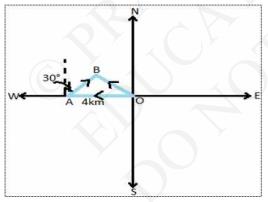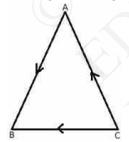Class 12 maths chapter 10 miscellaneous exercise solutions | miscellaneous exercise ch 10 class 12 | miscellaneous exercise chapter 10 class 12 | miscellaneous exercise class 12 chapter 10 | miscellaneous exercise on chapter 10 class 12 | vector algebra class 12 ncert solutions
Struggling with the challenging problems in Vector Algebra? The Class 12 Maths Chapter 10 Miscellaneous Exercise Solutions are your ultimate key to mastering every concept with ease. This section, known for its mixed variety of questions, tests your full understanding of the chapter. Whether you search for Miscellaneous Exercise Chapter 10 Class 12, Miscellaneous Exercise on Chapter 10 Class 12, or simply need a step-by-step approach to Vector Algebra Class 12 NCERT Solutions, these solutions cover it all in a simplified and exam-ready format. Sharpen your skills and build unbeatable confidence with these expertly crafted solutions.

class 12 maths chapter 10 miscellaneous exercise solutions || miscellaneous exercise on chapter 10 class 12 || vector algebra class 12 ncert solutions || miscellaneous exercise ch 10 class 12 || miscellaneous exercise class 12 chapter 10 || miscellaneous exercise chapter 10 class 12
Miscellaneous Exercise
1. Write down a unit vector in XY-plane, making an angle of \( 30^{\circ} \) with the positive direction of x -axis.
Answer
Given: A unit vector in XY- plane.
Let \( \overrightarrow{r} \) is a unit vector in the given XY- plane then the value of \( \overrightarrow{r} \) Will be: \( \overrightarrow{r}=\cos \theta \hat{\imath}+\sin \theta \hat{\jmath} \)
\( \theta \) is the angle given, which is made by unit vector with positive direction of \( x \)-axis.
\(\therefore \text { for } \theta=30^{\circ}\)
\(\overrightarrow{\mathrm{r}}=\cos 30^{\circ} \hat{\imath}+\sin 30^{\circ} \hat{\jmath}\)
\(\overrightarrow{\mathrm{r}}=\frac{\sqrt{3}}{2} \hat{\imath}+\frac{1}{2} \hat{\jmath}\)
Hence, the required unit vector is \( \frac{\sqrt{3}}{2} \hat{\imath}+\frac{1}{2} \hat{\jmath} \).
2. Find the scalar components and magnitude of the vector joining the points \( \mathrm{P}\left(x_{1}, y_{1}, z_{1}\right) \) and \( \mathrm{Q}\left(x_{2}, y_{2}, z_{2}\right) \).
Answer
Given: points \( \mathrm{P}\left(x_{1}, y_{1}, z_{1}\right) \) and \( \mathrm{Q}\left(x_{2}, y_{2}, z_{2}\right) \) are given.
The vector obtained by joining the given points P and Q :
\(\overrightarrow{\mathrm{PQ}}=\text { position vector of } \mathrm{Q}-\text { position vector of } \mathrm{P}\)
\(=\left(x_{2}-x_{1}\right) \hat{\imath}+\left(y_{2}-y_{1}\right) \hat{\jmath}+\left(z_{2}-z_{1}\right) \hat{\mathrm{k}}\)
\(\overrightarrow{\mathrm{PQ}}=\sqrt{\left(x_{2}-x_{1}\right)^{2}+\left(y_{2}-y_{1}\right)^{2}+\left(z_{2}-z_{1}\right)^{2}}\)
Hence the scalar component of the vector obtained by joining the points are
\(\left[\left(x_{2}-x_{1}\right),\left(y_{2}-y_{1}\right),\left(z_{2}-z_{1}\right)\right]\)
And the magnitude of the vector obtained by joining the points is
\(\sqrt{\left(x_{2}-x_{1}\right)^{2}+\left(y_{2}-y_{1}\right)^{2}+\left(z_{2}-z_{1}\right)^{2}}\)
3. A girl walks 4 km towards west, then she walks 3 km in a direction \( 30^{\circ} \) east of north and stops. Determine the girl's displacement from her initial point of departure.
Answer
let O be the initial position and B be the final position of the girl.
Position of girl will be as shown in figure:

Hence, \( \overrightarrow{\mathrm{OA}}=-4 \hat{\imath} \) and \( \angle B A O=60^{\circ} \)
\(\overrightarrow{\mathrm{AB}}=|\overrightarrow{\mathrm{AB}}| \cos 60^{\circ} \hat{\imath}+|\overrightarrow{\mathrm{AB}}| \sin 60^{\circ} \hat{\jmath}\)
\(=3 \times \frac{1}{2} \hat{\imath}+3 \times \frac{\sqrt{3}}{2} \hat{\jmath}\)
Now, by using triangle law of vector addition,
\(\overrightarrow{\mathrm{OB}}=\overrightarrow{\mathrm{OA}}+\overrightarrow{\mathrm{AB}}\)
\(=-4 \hat{\imath}+\frac{3}{2} \hat{\imath}+\frac{3 \sqrt{3}}{2} \hat{\jmath}\)
\(=\left(-4+\frac{3}{2}\right) \hat{\imath}+\frac{3 \sqrt{3}}{2} \hat{\jmath}\)
\(=\left(\frac{-8+3}{2}\right) \hat{\imath}+\frac{3 \sqrt{3}}{2} \hat{\jmath}\)
\(\Rightarrow \overrightarrow{\mathrm{OB}}=\left(\frac{-5}{2}\right) \hat{\imath}+\frac{3 \sqrt{3}}{2} \hat{\jmath}\)
Hence girls displacement from initial to final position is: \( \left(\frac{-5}{2}\right) \hat{\imath}+\frac{3 \sqrt{3}}{2} \hat{\jmath} \)
4. If \( |\overrightarrow{a}|=|\overrightarrow{b}|+|\overrightarrow{c}| \), then is it true that \( |\overrightarrow{a}|=|\overrightarrow{b}|+|\overrightarrow{c}| \) ? Justify your answer.
Answer
Let in given triangle \( \overrightarrow{C B}=\overrightarrow{a}, \overrightarrow{C A}=\overrightarrow{b} \), and \( \overrightarrow{A B}=\overrightarrow{c} \),

Now, by using triangle law of vector addition,
\(\overrightarrow{\mathrm{CB}}=\overrightarrow{\mathrm{CA}}+\overrightarrow{\mathrm{AB}}\)
\(\Rightarrow \overrightarrow{\mathrm{a}}=\overrightarrow{\mathrm{b}}+\overrightarrow{\mathrm{c}}\)
As we can see that \( |\overrightarrow{a}|,|\overrightarrow{b}| \) and \( |\overrightarrow{c}| \) represent the sides of triangle.
Also we know that sum of two sides of a triangle must be greater than its third side.
\(\Rightarrow|\overrightarrow{b}|+|\overrightarrow{c}| > |\overrightarrow{a}|\)
\(\Rightarrow|\overrightarrow{a}| \neq|\overrightarrow{b}|+|\overrightarrow{c}|\)
\(\therefore|\overrightarrow{a}|=|\overrightarrow{b}|+|\overrightarrow{c}| \text { is not true. }\)
5. Find the value of \( x \) for which \( x(\hat{\imath}+\hat{\jmath}+\hat{\mathrm{k}}) \) is a unit vector.
Answer
Given: \( x(\hat{\imath}+\hat{\jmath}+\hat{\mathrm{k}}) \) as a unit vector.
Now, if \( x(\hat{\imath}+\hat{\jmath}+\hat{k}) \) is a unit vector then
\(|x(\hat{\imath}+\hat{\jmath}+\hat{\mathrm{k}})|=1\)
\(\Rightarrow \sqrt{(x-0)^{2}+(x-0)^{2}+(x-0)^{2}}=1\)
\(\Rightarrow \sqrt{(x)^{2}+(x)^{2}+(x)^{2}}=1\)
\(\Rightarrow \sqrt{3(x)^{2}}=1\)
\(\Rightarrow x \sqrt{3}=1\)
\(\Rightarrow x= \pm \frac{1}{\sqrt{3}}\)
6. Find a vector of magnitude 5 units, and parallel to the resultant of the vectors \( \overrightarrow{a}=2 \hat{\imath}+3 \hat{\jmath}-\hat{k} \), and \( \overrightarrow{b}=\hat{\imath}-2 \hat{\jmath}+\hat{k} \)
Answer
Given: \( \overrightarrow{a}=(2 \hat{\imath}+3 \hat{\jmath}-\hat{k}) \), and \( \overrightarrow{b}=(\hat{\imath}-2 \hat{\jmath}+\hat{k}) \)
Let the resultant of \( \overrightarrow{a} \) and \( \overrightarrow{b} \) is \( \overrightarrow{c} \)
Then \( \overrightarrow{c}=\overrightarrow{a}+\overrightarrow{b} \)
\(\Rightarrow \overrightarrow{\mathrm{c}}=(2+1) \hat{\imath}+(3-2) \hat{\jmath}+(-1+1) \hat{\mathrm{k}}\)
\(\Rightarrow \overrightarrow{\mathrm{c}}=(3) \hat{\imath}+(1) \hat{\jmath}+(0) \hat{\mathrm{k}}\)
\(\Rightarrow \overrightarrow{\mathrm{c}}=3 \hat{\imath}+\hat{\jmath}\)
Then
\(|\overrightarrow{c}|=\sqrt{(3)^{2}+(1)^{2}}\)
\(\Rightarrow|\overrightarrow{c}|=\sqrt{9+1}\)
\(\Rightarrow|\overrightarrow{c}|=\sqrt{10}\)
\(\therefore \hat{c}=\frac{\overrightarrow{c}}{|\overrightarrow{c}|}=\frac{3 \hat{i}+\hat{\jmath}}{\sqrt{10}}\)
Now the vector of magnitude 5 units and parallel to \( \hat{c} \) is:
\(
\pm 5 \hat{\mathrm{c}}= \pm 5 \cdot \frac{3 \hat{\imath}+\hat{\jmath}}{\sqrt{10}}\)
\(= \pm \sqrt{5} \sqrt{5} \cdot \frac{3 \hat{\imath}+\hat{\jmath}}{\sqrt{2} \sqrt{5}}\)
\(= \pm \sqrt{5} \cdot \frac{3 \hat{\imath}+\hat{\jmath}}{\sqrt{2}} \times \frac{\sqrt{2}}{\sqrt{2}}\)
\(= \pm \sqrt{10} \cdot \frac{3 \hat{\imath}+\hat{\jmath}}{2}\)
\(= \pm \cdot \frac{3 \sqrt{10} \hat{\imath}}{2} \pm \frac{\sqrt{10}}{2} \hat{\jmath}\)
7. If \( \overrightarrow{a}=\hat{\imath}+\hat{\jmath}+\hat{k}, \overrightarrow{b}=2 \hat{\imath}-\hat{\jmath}+3 \hat{k} \), and \( \overrightarrow{c}=\hat{\imath}-2 \hat{\jmath}+\hat{k} \), find a unit vector parallel to the vector \( 2 \overrightarrow{a}-\overrightarrow{b}+3 \overrightarrow{c} \).
Answer
Given: \( \overrightarrow{a}=(\hat{\imath}+\hat{\jmath}+\hat{k}), \overrightarrow{b}=(2 \hat{\imath}-\hat{\jmath}+3 \hat{k}) \), and \( \overrightarrow{c}=(\hat{\imath}-2 \hat{\jmath}+\hat{k}) \)
Let the resultant of \( \overrightarrow{a} \) and \( \overrightarrow{b} \) is \( \overrightarrow{c} \)
Then \( \overrightarrow{2 a}-\overrightarrow{b}+3 \overrightarrow{c}=2(\hat{\imath}+\hat{\jmath}+\hat{k})-(2 \hat{\imath}-\hat{\jmath}+3 \hat{k})+3(\hat{\imath}-2 \hat{\jmath}+\hat{k}) \)
\(=(2-2+3) \hat{\imath}+(2+1-6) \hat{\jmath}+(2-3+3) \hat{k}\)
\(=(3) \hat{\imath}+(-3) \hat{\jmath}+(2) \hat{k}\)
\(\Rightarrow \overrightarrow{2 \mathrm{a}}-\overrightarrow{\mathrm{b}}+3 \overrightarrow{\mathrm{c}}=3 \hat{\imath}-3 \hat{\jmath}+2 \hat{\mathrm{k}}\)
Then
\(|\overrightarrow{2 a}-\overrightarrow{b}+3 \overrightarrow{c}|=\sqrt{(3)^{2}+(-3)^{2}+(2)^{2}}\)
\(\Rightarrow|\overrightarrow{2 a}-\overrightarrow{b}+3 \overrightarrow{c}|=\sqrt{9+9+4}\)
\(\Rightarrow|\overrightarrow{2 a}-\overrightarrow{b}+3 \overrightarrow{c}|=\sqrt{22}\)
\( \therefore \) unit vector along \( \overrightarrow{2 a}-\overrightarrow{b}+3 \overrightarrow{c}=\frac{\overrightarrow{2 a}-\overrightarrow{b}+3 \overrightarrow{c}}{|\overrightarrow{2 a}-\overrightarrow{b}+3 \overrightarrow{c}|}=\frac{3 \hat{\imath}-3 \hat{\jmath}+2 \hat{k}}{\sqrt{22}} \)
\(=\frac{3}{\sqrt{22}} \hat{\imath}-\frac{3}{\sqrt{22}} \hat{\jmath}+\frac{2}{\sqrt{22}} \hat{k}\)
8. Show that the points A \( (1,-2,-8), \mathrm{B}(5,0,-2) \) and \( \mathrm{C}(11 \), \( 3,7) \) are collinear, and find the ratio in which \( B \) divides \( A C \).
Answer
Given: \( \mathrm{A}(1,-2,-8), \mathrm{B}(5,0,-2) \) and \( \mathrm{C}(11,3,7) \)
Then
\(\overrightarrow{\mathrm{AB}}=(5-1) \hat{\imath}-(0-(-2)) \hat{\jmath}+(-2-(-8)) \hat{\mathrm{k}}\)
\(\Rightarrow \overrightarrow{\mathrm{AB}}=(4) \hat{\imath}-(2) \hat{\jmath}+(6) \hat{\mathrm{k}}\)
\(\overrightarrow{\mathrm{BC}}=(11-5) \hat{\imath}-(3-0) \hat{\jmath}+(7-(-2)) \hat{\mathrm{k}}\)
\(\Rightarrow \overrightarrow{\mathrm{BC}}=(6) \hat{\imath}-(3) \hat{\jmath}+(9) \hat{\mathrm{k}}\)
\(\overrightarrow{\mathrm{AC}}=(11-1) \hat{\imath}-(3-(-2)) \hat{\jmath}+(7-(-8)) \hat{\mathrm{k}}\)
\(\Rightarrow \overrightarrow{\mathrm{BC}}=10 \hat{\imath}+5 \hat{\jmath}+15 \hat{\mathrm{k}}\)
Then
\(|\overrightarrow{\mathrm{AB}}|=\sqrt{(4)^{2}+(2)^{2}+(6)^{2}}\)
\(=\sqrt{16+4+36}\)
\(\Rightarrow|\overrightarrow{\mathrm{AB}}|=\sqrt{56}=2 \sqrt{14}\)
\(|\overrightarrow{\mathrm{BC}}|=\sqrt{(6)^{2}+(3)^{2}+(9)^{2}}\)
\(=\sqrt{36+9+81}\)
\(\Rightarrow|\overrightarrow{\mathrm{BC}}|=\sqrt{126}=3 \sqrt{14}\)
\(|\overrightarrow{\mathrm{AC}}|=\sqrt{(10)^{2}+(5)^{2}+(15)^{2}}\)
\(=\sqrt{100+25+225}\)
\(\Rightarrow|\overrightarrow{\mathrm{AC}}|=\sqrt{350}=5 \sqrt{14}\)
\(\therefore|\overrightarrow{\mathrm{AC}}|=|\overrightarrow{\mathrm{BC}}|+|\overrightarrow{\mathrm{AB}}|\)
Thus the given points are collinear.
Now to find the ratio in which B divides AC. Let it be \( \lambda: 1 \)
\(\overrightarrow{\mathrm{OB}}=\frac{\lambda \cdot \overrightarrow{\mathrm{OC}}+1 \cdot \overrightarrow{\mathrm{OA}}}{\lambda+1}\)
\(\Rightarrow \overrightarrow{\mathrm{OB}}=\frac{\lambda \cdot \overrightarrow{\mathrm{OC}}+1 \cdot \overrightarrow{\mathrm{OA}}}{\lambda+1}\)
\(\Rightarrow 5 \hat{\mathrm{i}}+2 \hat{\mathrm{k}}=\frac{\lambda \cdot(11 \hat{\imath}+3 \hat{\jmath}+7 \widehat{\mathrm{k}})+1 \cdot(\hat{\mathrm{i}}-2 \hat{\jmath}-8 \widehat{\mathrm{k}})}{\lambda+1}\)
\(\Rightarrow 5 \hat{\imath}+2 \hat{\mathrm{k}}(\lambda+1)=\lambda \cdot(11 \hat{\imath}+3 \hat{\jmath}+7 \hat{\mathrm{k}})+1 \cdot(\hat{\imath}-2 \hat{\jmath}-8 \hat{\mathrm{k}})\)
\(\Rightarrow(5(\lambda+1) \hat{\imath}-2(\lambda+1) \hat{\mathrm{k}})=(11 \lambda+1) \hat{\imath}+(3 \lambda-2) \hat{\jmath}+(7 \lambda-8) \hat{\mathrm{k}}\)
On equating the terms, we get:
\(5(\lambda+1)=11 \lambda+1\)
\(\Rightarrow 5 \lambda+5=11 \lambda+1\)
\(\Rightarrow 4=6 \lambda\)
\(\Rightarrow \lambda=\frac{4}{6}=\frac{2}{3}\)
Hence, B divides AC in the ratio 2:3.
9. Find the position vector of a point \( R \) which divides the line joining two points \( P \) and \( Q \) whose position vectors are \( (2 \overrightarrow{a}+\overrightarrow{b}) \) and \( (\overrightarrow{a}-3 \overrightarrow{b}) \) externally in the ratio \( 1: 2 \). Also, show that \( P \) is the midpoint of the line segment RQ .
Answer
Given: points P \( (2 \overrightarrow{a}+\overrightarrow{b}) \) and \( Q(\overrightarrow{a}-3 \overrightarrow{b}) \) are given.
Point R is given which divides P and Q in the ratio 1:2.
Then
\(\overrightarrow{\mathrm{OR}}=\frac{2 \cdot(2 \overrightarrow{a}+\overrightarrow{b})-1 \cdot(\overrightarrow{a}-3 \overrightarrow{b})}{2-1}\)
\(\Rightarrow \overrightarrow{O R}=\frac{(4 \overrightarrow{a}+2 \overrightarrow{b})-(\overrightarrow{a}-3 \overrightarrow{b})}{1}\)
\(\Rightarrow \overrightarrow{O R}=(3 \overrightarrow{a}+5 \overrightarrow{b})\)
\( \therefore \) position vector of \( R \) is \( (3 \overrightarrow{a}+5 \overrightarrow{b}) \)
And position vector of mid-point of \( \mathrm{RQ}=\frac{(\overrightarrow{\mathrm{OQ}}+\overrightarrow{\mathrm{OR}})}{2} \)
\(\frac{((\overrightarrow{a}-3 \overrightarrow{b})+(3 \overrightarrow{a}+5 \overrightarrow{b}))}{2}=\frac{1}{2}(4 \overrightarrow{a}+2 \overrightarrow{b})=(2 \overrightarrow{a}+\overrightarrow{b})=\overrightarrow{O P}\)
Hence, P is mid-point of the line segment RQ.
class 12 maths chapter 10 miscellaneous exercise solutions || miscellaneous exercise on chapter 10 class 12 || vector algebra class 12 ncert solutions || miscellaneous exercise ch 10 class 12 || miscellaneous exercise class 12 chapter 10 || miscellaneous exercise chapter 10 class 12
10. The two adjacent sides of a parallelogram are \( 2 \hat{\imath}-4 \hat{\jmath}+5 \hat{k} \) and \( \hat{\imath}-2 \hat{\jmath}-3 \hat{k} \). Find the unit vector parallel to its diagonal. Also, find its area.
Answer
Given: Two adjacent sides of a parallelogram are
\(\overrightarrow{a}=(2 \hat{\imath}-4 \hat{\jmath}+5 \hat{k}) \text { and } \overrightarrow{b}=(\hat{\imath}-2 \hat{\jmath}-3 \hat{k})\)
Then the diagonal of parallelogram is given by the resultant of \( \overrightarrow{a} \) and \( \overrightarrow{b} \).
Let the diagonal is \( \overrightarrow{\mathrm{c}} \)
Then \( \overrightarrow{c}=\overrightarrow{a}+\overrightarrow{b} \)
\(\Rightarrow \overrightarrow{\mathrm{c}}=(2+1) \hat{\imath}+(-4-2) \hat{\jmath}+(5-3) \hat{\mathrm{k}}\)
\(\Rightarrow \overrightarrow{\mathrm{c}}=(3) \hat{\imath}+(-6) \hat{\jmath}+(2) \hat{\mathrm{k}}\)
\(\Rightarrow \overrightarrow{\mathrm{c}}=3 \hat{\imath}-6 \hat{\jmath}+2 \hat{\mathrm{k}}\)
Then
\(|\overrightarrow{c}|=\sqrt{(3)^{2}+(-6)^{2}+(2)^{2}}\)
\(\Rightarrow|\overrightarrow{c}|=\sqrt{9+36+4}\)
\(\Rightarrow|\overrightarrow{c}|=\sqrt{49}=7\)
\(\therefore \hat{c}=\frac{\overrightarrow{c}}{|\overrightarrow{c}|}=\frac{3 \hat{\imath}-6 \hat{\jmath}+2 \hat{k}}{7}\)
\( \therefore \) unit vector parallel to its diagonal is \( \hat{\mathrm{c}}=\frac{3}{7} \hat{\imath}-\frac{6}{7} \hat{\mathrm{\jmath}}+\frac{2}{7} \hat{\mathrm{k}} \)
And area of parallelogram \( A B C D \) is \( |\overrightarrow{a} \times \overrightarrow{b}| \).
\(\begin{array}{l}
\overrightarrow{a} \times \overrightarrow{b}=\left|\begin{array}{rrr}
\hat{\imath} & \hat{\jmath} & \hat{k} \\
2 & -4 & 5 \\
1 & -2 & -3
\end{array}\right| \\
=\hat{\imath}(12+10)-\hat{\jmath}(-6-5)+\hat{k}(-4+4) \\
=22 \hat{\imath}+11 \hat{\jmath} \\
=11(2 \hat{\imath}+\hat{\jmath}) \\
\therefore|\overrightarrow{a} \times \overrightarrow{b}|=11 \sqrt{(2)^{2}+(1)^{2}}=11 \sqrt{5}
\end{array}\)
Hence, area of parallelogram ABCD is \( 11 \sqrt{5} \)
11. Show that the direction cosines of a vector equally inclined to the axes OX, OY and OZ are \( \frac{1}{\sqrt{3}}, \frac{1}{\sqrt{3}}, \frac{1}{\sqrt{3}} \).
Answer
let the vector equally inclined to \( \mathrm{OX}, \mathrm{OY} \) and OZ at angle \( \alpha \).
Then the direction cosine of the vectors is \( \cos \alpha, \cos \alpha \) and \( \cos \alpha \).
Because,
\(\operatorname{Cos}^{2} \alpha+\cos ^{2} \alpha+\cos ^{2} \alpha=1\)
\(\Rightarrow 3 \operatorname{Cos}^{2} \alpha=1\)
\(\Rightarrow \cos ^{2} \alpha=\frac{1}{3}\)
\(\Rightarrow \cos \alpha=\frac{1}{\sqrt{3}}\)
Hence, the direction cosines of the vector which are equally inclined to the axis are
\(\left(\frac{1}{\sqrt{3}}, \frac{1}{\sqrt{3}}, \frac{1}{\sqrt{3}}\right)\)
12. Let \( \overrightarrow{a}=\hat{\imath}+4 \hat{\jmath}+2 \hat{k}, \overrightarrow{b}=3 \hat{\imath}-2 \hat{\jmath}+7 \hat{k} \), and \( \overrightarrow{c}=2 \hat{\imath}-\hat{\jmath}+4 \hat{k} \). Find a vector \( \overrightarrow{d} \) which is perpendicular to both \( \overrightarrow{a} \) and \( \overrightarrow{b} \), and \( \overrightarrow{c} \cdot \overrightarrow{d}=15 \)
Answer
Given: \( \overrightarrow{a}=\hat{\imath}+4 \hat{\jmath}+2 \hat{k}, \overrightarrow{b}=3 \hat{\imath}-2 \hat{\jmath}+7 \hat{k} \), and \( \overrightarrow{c}=2 \hat{\imath}-\hat{\jmath}+4 \hat{k} \).
Let \( \overrightarrow{d}=\left(d_{1} \hat{\imath}+d_{2} \hat{\jmath}+d_{3} \hat{k}\right) \)
Because \( \overrightarrow{d} \) is perpendicular to both \( \overrightarrow{a} \) and \( \overrightarrow{b} \).
\( \Rightarrow \overrightarrow{\mathrm{d}} \cdot \overrightarrow{\mathrm{a}}=0 \) and \( \overrightarrow{\mathrm{d}} \cdot \overrightarrow{\mathrm{b}}=0 \)
Then \( \overrightarrow{d} \cdot \overrightarrow{a}=\left(d_{1} \hat{\imath}+d_{2} \hat{\jmath}+d_{3} \hat{k}\right) \cdot(\hat{\imath}+4 \hat{\jmath}+2 \hat{k})=0 \)
\( \mathrm{d}_{1}+4 \mathrm{~d}_{2}+2 \mathrm{~d}_{3}=0 \ldots (1) \)
And \( \overrightarrow{d} \cdot \overrightarrow{b}=\left(d_{1} \hat{\imath}+d_{2} \hat{\jmath}+d_{3} \hat{k}\right) \cdot(3 \hat{\imath}-2 \hat{\jmath}+7 \hat{k})=0 \)
\( 3 \mathrm{~d}_{1}-2 \mathrm{~d}_{2}+7 \mathrm{~d}_{3}=0 \ldots (2)\)
And \( \overrightarrow{\mathrm{c}} . \overrightarrow{\mathrm{d}}=15 \) (given)
\(\Rightarrow \overrightarrow{\mathrm{c}} \cdot \overrightarrow{\mathrm{d}}=\left(\mathrm{d}_{1} \hat{\imath}+\mathrm{d}_{2} \hat{\jmath}+\mathrm{d}_{3} \hat{\mathrm{k}}\right) \cdot(2 \hat{\imath}-\hat{\jmath}+4 \hat{\mathrm{k}})=15\)
\(2 \mathrm{~d}_{1}-\mathrm{d}_{2}+4 \mathrm{~d}_{3}=15\ldots (3)\)
So we have the equations to solve as, \( \mathrm{d}_{1}+4 \mathrm{~d}_{2}+2 \mathrm{~d}_{3}=0 \)
\(3 \mathrm{~d}_{1}-2 \mathrm{~d}_{2}+7 \mathrm{~d}_{3}=0\)
\(2 \mathrm{~d}_{1}-\mathrm{d}_{2}+4 \mathrm{~d}_{3}=15\)
From equation (1), \( d_{1}=-4 d_{2}-2 d_{3} \ldots (4)\)
Putting this value in equation 2 we get, \( -12 \mathrm{~d}_{2}-6 \mathrm{~d}_{3}-2 \mathrm{~d}_{2}+7 \mathrm{~d}_{3}=0 \)
Therefore, \( 14 \mathrm{~d}_{2}=\mathrm{d}_{3} \) \( \qquad \)
Now putting the value of \( d_{3} \) in equation 4 we get,
\(\mathrm{d}_{1}=-4 \mathrm{~d}_{2}-28 \mathrm{~d}_{2}\)
\( d_{1}=-32 d_{2} \ldots(6)\)
Putting (5) and (6) in equation (3) we get, \( -64 \mathrm{~d}_{2}-\mathrm{d}_{2}+56 \mathrm{~d}_{2}=15 \)
\(-9 d_{2}=15\)
\(d_{2}=-\frac{5}{3}\)
Now we can find other values as well,
\(\mathrm{d}_{1}=\frac{160}{3}, \mathrm{~d}_{2}=-\frac{5}{3} \text { and } \mathrm{d}_{3}=-\frac{70}{3}\)
Hence \( \overrightarrow{\mathrm{d}}=\left(\frac{160}{3} \hat{\imath}-\frac{5}{3} \hat{\jmath}-\frac{70}{3} \hat{\mathrm{k}}\right) \)
\(\overrightarrow{\mathrm{d}}=\frac{1}{3}(160 \hat{\imath}-5 \hat{\jmath}-70 \hat{\mathrm{k}})
\)
Hence, the required vector is \( \frac{1}{3}(160 \hat{\imath}-5 \hat{\jmath}-70 \hat{k}) \)
13. The scalar product of the vector \( \hat{\imath}+\hat{\jmath}+\hat{k} \) a unit vector along the sum of vectors \( 2 \hat{\imath}+4 \hat{\jmath}-5 \hat{k} \) and \( \lambda \hat{\imath}+2 \hat{\jmath}+3 \hat{k} \) is equal to one. Find the value of \( \lambda \).
Answer
Given: given vectors are \( \overrightarrow{a}=(2 \hat{\imath}+4 \hat{\jmath}-5 \hat{k}) \) and \( \overrightarrow{b}=(\lambda \hat{\imath}+2 \hat{\jmath}+3 \hat{k}) \),
Then sum of vector is given by the resultant of \( \overrightarrow{a} \) and \( \overrightarrow{b} \).
Let the sum is \( \overrightarrow{c} \).
Then \( \overrightarrow{\mathrm{c}}=\overrightarrow{\mathrm{a}}+\overrightarrow{\mathrm{b}} \)
\(\Rightarrow \overrightarrow{\mathrm{c}}=(2+\lambda) \hat{\imath}+(4+2) \hat{\jmath}+(-5+3) \hat{\mathrm{k}}\)
\(\Rightarrow \overrightarrow{\mathrm{c}}=(2+\lambda) \hat{\imath}+(6) \hat{\jmath}+(-2) \hat{\mathrm{k}}\)
\(\Rightarrow \overrightarrow{\mathrm{c}}=(2+\lambda) \hat{\imath}+6 \hat{\jmath}-2 \hat{\mathrm{k}}\)
Then
\(|\overrightarrow{c}|=\sqrt{(2+\lambda)^{2}+(6)^{2}+(-2)^{2}}\)
\(\Rightarrow|\overrightarrow{c}|=\sqrt{4+(\lambda)^{2}+4 \lambda+36+4}\)
\(\Rightarrow|\overrightarrow{c}|=\sqrt{(\lambda)^{2}+4 \lambda+44}\)
\(\therefore \hat{\mathrm{c}}=\frac{\overrightarrow{\mathrm{c}}}{|\overrightarrow{\mathrm{c}}|}=\frac{(2+\lambda) \hat{\mathrm{i}}+6 \hat{\jmath}-2 \widehat{\mathrm{k}}}{\sqrt{(\lambda)^{2}+4 \lambda+44}}\)
Scalar product of \( \hat{\imath}+\hat{\jmath}+\hat{k} \) and \( \hat{c} \) is 1 .
\(\Rightarrow(\hat{\imath}+\hat{\jmath}+\hat{k}) \cdot \frac{(2+\lambda) \hat{\imath}+6 \hat{\jmath}-2 \widehat{k}}{\sqrt{(\lambda)^{2}+4 \lambda+44}}=1\)
\(\Rightarrow \frac{(2+\lambda)+6-2}{\sqrt{(\lambda)^{2}+4 \lambda+44}}=1\)
\(\Rightarrow(2+\lambda)+4=\sqrt{(\lambda)^{2}+4 \lambda+44}\)
\(\Rightarrow(\lambda+6)=\sqrt{(\lambda)^{2}+4 \lambda+44}\)
Square on both sides:
\(\Rightarrow(\lambda+6)^{2}=(\lambda)^{2}+4 \lambda+44\)
\(\Rightarrow(\lambda)^{2}+12 \lambda+36=(\lambda)^{2}+4 \lambda+44\)
\(\Rightarrow 8 \lambda=8\)
\(\Rightarrow \lambda=1\)
14. If \( \overrightarrow{a}, \overrightarrow{b}, \overrightarrow{c} \) are mutually perpendicular vectors of equal magnitudes, show that the vector \( \overrightarrow{a}+\overrightarrow{b}+\overrightarrow{c} \) is equally inclined to \( \overrightarrow{a}, \overrightarrow{b} \), and \( \overrightarrow{\mathrm{c}} \)
Answer
Given: vectors \( \overrightarrow{a}, \overrightarrow{b} \), and \( \overrightarrow{c} \) are mutually perpendicular to each other and are of equal magnitude.
\(\Rightarrow \overrightarrow{a} \cdot \overrightarrow{b}=\overrightarrow{b} \cdot \overrightarrow{c}=\overrightarrow{c} \cdot \overrightarrow{a}=0\)
Let the vector \( \overrightarrow{a}+\overrightarrow{b}+\overrightarrow{c} \) be inclined to \( \overrightarrow{a}, \overrightarrow{b} \), and \( \overrightarrow{c} \) at angles \( \alpha, \beta \) and \( \gamma \) respectively.
Then, we have
\(\cos \alpha=\frac{(\overrightarrow{a}+\overrightarrow{b}+\overrightarrow{c}) \cdot \overrightarrow{a}}{|\overrightarrow{a}+\overrightarrow{b}+\overrightarrow{c}| \cdot|\overrightarrow{a}|}\)
\(=\frac{(\overrightarrow{a} \cdot \overrightarrow{a}+\overrightarrow{b} \cdot \overrightarrow{a}+\overrightarrow{c} \cdot \overrightarrow{a})}{|\overrightarrow{a}+\overrightarrow{b}+\overrightarrow{c}| \cdot \overrightarrow{a} \mid}\)
\(=\frac{\left(|\overrightarrow{a}|^{2}+0+0\right)}{|\overrightarrow{a}+\overrightarrow{b}+\overrightarrow{c}| \cdot \overrightarrow{a} \mid}=\frac{|\overrightarrow{a}|}{|\overrightarrow{a}+\overrightarrow{b}+\overrightarrow{c}|} \ldots (1)\)
\(\cos \beta=\frac{(\overrightarrow{a}+\overrightarrow{b}+\overrightarrow{c}) \cdot \overrightarrow{b}}{|\overrightarrow{a}+\overrightarrow{b}+\overrightarrow{c}| \cdot|\overrightarrow{b}|}\)
\(=\frac{(\overrightarrow{a} \cdot \overrightarrow{b}+\overrightarrow{b} \cdot \overrightarrow{b}+c \overrightarrow{b})}{|\overrightarrow{a}+\overrightarrow{b}+\overrightarrow{c}| \cdot \overrightarrow{b} \mid}\)
\(=\frac{\left(0+|\overrightarrow{b}|^{2}+0\right)}{|\overrightarrow{a}+\overrightarrow{b}+\overrightarrow{c}| \cdot \overrightarrow{b} \mid}=\frac{|\overrightarrow{b}|}{|\overrightarrow{a}+\overrightarrow{b}+\overrightarrow{c}|}\ldots (2)\)
\(\cos \gamma=\frac{(\overrightarrow{a}+\overrightarrow{b}+\overrightarrow{c}) \cdot \overrightarrow{a}}{|\overrightarrow{a}+\overrightarrow{b}+\overrightarrow{c}| \cdot \overrightarrow{a} \mid}\)
\(=\frac{(\overrightarrow{a} \cdot \overrightarrow{c}+\overrightarrow{b} \cdot \overrightarrow{c}+\overrightarrow{c} \cdot \overrightarrow{c})}{|\overrightarrow{a}+\overrightarrow{b}+\overrightarrow{c}| \cdot \overrightarrow{a} \mid}\)
\(=\frac{\left(0+0+|\overrightarrow{c}|^{2}\right)}{|\overrightarrow{a}+\overrightarrow{b}+\overrightarrow{c}| \cdot|\overrightarrow{a}|}=\frac{|\overrightarrow{a}|}{|\overrightarrow{a}+\overrightarrow{b}+\overrightarrow{c}|}\ldots (3)\)
From (1), (2) and (3)
As \( |\overrightarrow{a}|=|\overrightarrow{b}|=|\overrightarrow{c}| \)
Hence, \( \cos \alpha=\cos \beta=\cos \gamma \)
\(\Rightarrow \alpha=\beta=\gamma\)
Hence, the vector \( \overrightarrow{a}+\overrightarrow{b}+\overrightarrow{c} \) are equal inclined to \( \overrightarrow{a}, \overrightarrow{b} \), and \( \overrightarrow{c} \).
15. Prove that \( (\overrightarrow{a}+\overrightarrow{b}) \cdot(\overrightarrow{a}+\overrightarrow{b})=|\overrightarrow{a}|^{2}+|\overrightarrow{b}|^{2} \), if and only if are perpendicular, given \( \overrightarrow{a} \neq \overrightarrow{0}, \overrightarrow{b} \neq \overrightarrow{0} \).
Answer
given: \( (\overrightarrow{a}+\overrightarrow{b}) \cdot(\overrightarrow{a}+\overrightarrow{b})=|\overrightarrow{a}|^{2}+|\overrightarrow{b}|^{2} \)
To prove: vectors \( \overrightarrow{a} \) and \( \overrightarrow{b} \) are mutually perpendicular to each other.
\(\Rightarrow \overrightarrow{a} \cdot \overrightarrow{b}=0\)
\(\because(\overrightarrow{a}+\overrightarrow{b}) \cdot(\overrightarrow{a}+\overrightarrow{b})=|\overrightarrow{a}|^{2}+|\overrightarrow{b}|^{2}\)
\(\Rightarrow(\overrightarrow{a} \cdot \overrightarrow{a}+\overrightarrow{a} \cdot \overrightarrow{b}+\overrightarrow{b} \cdot \overrightarrow{a}+\overrightarrow{b} \cdot \overrightarrow{b})=|\overrightarrow{a}|^{2}+|\overrightarrow{b}|^{2}\)
\(\Rightarrow(\overrightarrow{a} \cdot \overrightarrow{b}=\overrightarrow{b} \cdot \overrightarrow{a}) \text { scalar product is commutative. }\)
\(\Rightarrow\left(|\overrightarrow{a}|^{2}+|\overrightarrow{b}|^{2}+2 \overrightarrow{a} \cdot \overrightarrow{b}\right)=|\overrightarrow{a}|^{2}+|\overrightarrow{b}|^{2}\)
\(\Rightarrow(2 \overrightarrow{a} \cdot \overrightarrow{b})=0\)
\(\Rightarrow \overrightarrow{a} \cdot \overrightarrow{b}=0\)
Hence, \( \overrightarrow{a} \) and \( \overrightarrow{b} \) are mutually perpendicular to each other.as \( \overrightarrow{a} \neq 0, \overrightarrow{b} \neq \) 0 is given.
class 12 maths chapter 10 miscellaneous exercise solutions || miscellaneous exercise on chapter 10 class 12 || vector algebra class 12 ncert solutions || miscellaneous exercise ch 10 class 12 || miscellaneous exercise class 12 chapter 10 || miscellaneous exercise chapter 10 class 12
16. If \( \theta \) is the angle between two vectors \( \overrightarrow{a} \) and \( \overrightarrow{b} \), then \( \overrightarrow{a} . \overrightarrow{b} \geq 0 \) only when
A. \( 0 < \theta < \frac{\pi}{2} \)
B. \( 0 \leq \theta < \frac{\pi}{2} \)
C. \( 0 < \theta < \pi \)
D. \( 0 \leq \theta < \pi \)
A. \( 0 < \theta < \frac{\pi}{2} \)
B. \( 0 \leq \theta < \frac{\pi}{2} \)
C. \( 0 < \theta < \pi \)
D. \( 0 \leq \theta < \pi \)
Answer
let \( \theta \) is the angle between two vectors \( \overrightarrow{a} \) and \( \overrightarrow{b} \).
Then \( \overrightarrow{a} \) and \( \overrightarrow{b} \) are non-zero vectors so that \( |\overrightarrow{a}| \) and \( |\overrightarrow{b}| \) are positive.
As we know \( \overrightarrow{a} \cdot \overrightarrow{b}=|\overrightarrow{a}||\overrightarrow{b}| \cos \theta \)
For \( \overrightarrow{a} . \overrightarrow{b} > 0 \)
\( \Rightarrow|\overrightarrow{a}||\overrightarrow{b}| \cos \theta > 0 \)
As \( |\overrightarrow{a}| \) and \( |\overrightarrow{b}| \) are positive.
\(\Rightarrow \cos \theta > 0\)
\(\Rightarrow 0 \leq \theta < \frac{\pi}{2}\)
Hence, \( \overrightarrow{a} \cdot \overrightarrow{b} > 0 \) when \( 0 \leq \theta < \frac{\pi}{2} \)
The correct answer is (B).
17. Let \( \overrightarrow{a} \) and \( \overrightarrow{b} \) be two unit vectors and \( q \) is the angle between them. Then \( \overrightarrow{a}+\overrightarrow{b} \) is a unit vector if
A. \( \theta=\frac{\pi}{4} \)
B. \( \theta=\frac{\pi}{3} \)
C. \( \theta=\frac{\pi}{2} \)
D. \( \theta=\frac{2 \pi}{3} \)
A. \( \theta=\frac{\pi}{4} \)
B. \( \theta=\frac{\pi}{3} \)
C. \( \theta=\frac{\pi}{2} \)
D. \( \theta=\frac{2 \pi}{3} \)
Answer
let the two unit vectors are \( \overrightarrow{a} \) and \( \overrightarrow{b} \) and \( \theta \) is the angle between.
Then \( |\overrightarrow{a}|=|\overrightarrow{b}|=1 \)
Then this is \( (\overrightarrow{a}+\overrightarrow{b}) \) is unit vector if \( |\overrightarrow{a}+\overrightarrow{b}|=1 \)
\(|\overrightarrow{a}+\overrightarrow{b}|=1\)
\(\Rightarrow|\overrightarrow{a}+\overrightarrow{b}|^{2}=(1)^{2}\)
\(\Rightarrow(\overrightarrow{a}+\overrightarrow{b}) \cdot(\overrightarrow{a}+\overrightarrow{b})=1\)
\(\Rightarrow(\overrightarrow{a} \cdot \overrightarrow{a}+\overrightarrow{a} \cdot \overrightarrow{b}+\overrightarrow{b} \cdot \overrightarrow{a}+\overrightarrow{b} \cdot \overrightarrow{b})=1\)
\(\Rightarrow(\overrightarrow{a} \cdot \overrightarrow{b}=\overrightarrow{b} \cdot \overrightarrow{a}) \text { scalar product is commutative. }\)
\(\Rightarrow\left(|\overrightarrow{a}|^{2}+|\overrightarrow{b}|^{2}+2 \overrightarrow{a} \cdot \overrightarrow{b}\right)=1\)
\(\Rightarrow(1+1+2 \overrightarrow{a} \cdot \overrightarrow{b})=1\)
\(\Rightarrow 2+2\left(|\overrightarrow{a}|^{2}|\overrightarrow{b}|^{2} \cos \theta\right)=1\)
\(\Rightarrow \cos \theta=-\frac{1}{2}\)
\(\Rightarrow \theta=\frac{2 \pi}{3}\)
Hence, \( (\overrightarrow{a}+\overrightarrow{b}) \) is unit vector if \( \theta=\frac{2 \pi}{3} \)
The correct answer is (D).
18. The value of \( \hat{\imath}(\hat{\jmath} \times \hat{k})+\hat{\jmath}(\hat{\imath} \times \hat{k})+\hat{k}(\hat{\imath} \times \hat{\jmath}) \) is
A. 0
B. \(-1\)
C. 1
D. 3
A. 0
B. \(-1\)
C. 1
D. 3
Answer
\(\text { given: } \hat{\imath}(\hat{\jmath} \times \hat{\mathrm{k}})+\hat{\jmath}(\hat{\imath} \times \hat{\mathrm{k}})+\hat{\mathrm{k}}(\hat{\imath} \times \hat{\jmath})\)
\(\hat{\imath}(\hat{\jmath} \times \hat{\mathrm{k}})+\hat{\jmath}(\hat{\imath} \times \hat{\mathrm{k}})+\hat{\mathrm{k}}(\hat{\imath} \times \hat{\jmath})=\hat{\imath} \cdot \hat{\imath}+\hat{\jmath} \cdot(-\hat{\jmath})+\hat{\mathrm{k}} \cdot \hat{\mathrm{k}}\)
\(=1-\hat{\jmath} \cdot \hat{\jmath}+1\)
\(=1-1+1\)
\(=1\)
The correct answer is (C).
19. If \( \theta \) is the angle between any two vectors \( \overrightarrow{a} \) and \( \overrightarrow{b} \), then \( |\overrightarrow{a} \cdot \overrightarrow{b}|=|\overrightarrow{a} \times \overrightarrow{b}| \) when \( \theta \) is equal to
A. 0
B. \( \frac{\pi}{4} \)
C. \( \frac{\pi}{2}\)
D. \( \pi \)
A. 0
B. \( \frac{\pi}{4} \)
C. \( \frac{\pi}{2}\)
D. \( \pi \)
Answer
let \( \theta \) is the angle between two vectors \( \overrightarrow{a} \) and \( \overrightarrow{b} \).
Then \( \overrightarrow{a} \) and \( \overrightarrow{b} \) are non-zero vectors so that are positive.
\(|\overrightarrow{a} \cdot \overrightarrow{b}|=|\overrightarrow{a} \times \overrightarrow{b}|\)
\(\Rightarrow|\overrightarrow{a}||\overrightarrow{b}| \cos \theta=|\overrightarrow{a}||\overrightarrow{b}| \sin \theta\)
\(\Rightarrow \cos \theta=\sin \theta\)
\(\Rightarrow 1=\frac{\sin \theta}{\cos \theta}\)
\(\Rightarrow \tan \theta=1\)
\(\Rightarrow \theta=\frac{\pi}{4}\)
Thus \( |\overrightarrow{a} \cdot \overrightarrow{b}|=|\overrightarrow{a} \times \overrightarrow{b}| \) when \( \theta=\frac{\pi}{4} \).
The correct answer is (B).
